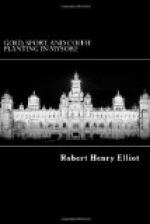Mysore is a tract of country in Southern India approximating in area to Scotland, and with a general elevation of from two to three thousand feet above the level of the sea. It is commonly spoken of as the Mysore tableland, but this is rather a misleading description if we adopt the dictionary definition of the word tableland as being “a tract of country at once elevated and level,” for, though there are in the interior of the province considerable stretches of rolling plains, the so-called tableland presents to the view a country intersected at intervals, more or less remote, with mountain chains, while scattered here and there in the interior of the plateau are isolated rocky hills, or rather hills of rock, termed droogs (Sanscrit, durga, or difficult of access) which sometimes rise to a total height of 5,000 feet above sea level. The surface of the country, too, is often broken by groups, or clusters of rocks, either low or of moderate elevation, composed of immense boulders, the topmost ones of which are often so finely poised as to seem ready to topple over at the slightest touch. The highest point of the plateau is about 3,500 feet, and is crowned as it were by the fine bold range of the Bababuden mountains, which have an average elevation of about 6,000 feet. There are three mountains in Mysore which exceed this elevation, and the highest of them, Mulainagiri, is 6,317 feet above the level of the sea. The province, which is completely surrounded by British territory, is flanked on the west and east by the Ghauts, or ranges of hills up the passes through which the traveller ascends on to the tableland, and on the south it is, as it were, pointed off by the Nilgiri hills. The greatest breadth of Mysore from north to south is about 230 miles, and its greatest length from east to west is 290 miles. On the western side one part of the province runs to within ten miles of the sea, though the average distance from it is from thirty to fifty miles. The nearest point to the sea on the eastern side is about 120 miles, and the most southerly extremity of the tableland is 250 miles from the most southerly point of India.
As regards climate, cultivation, and the general appearance of the country, Mysore may be divided into two very distinctly marked tracts—the forest and woodland region which stretches from the foot of the Western Ghauts to distances varying from about twenty to as much as forty-five miles, and the rolling and comparatively speaking treeless plains of the central and eastern parts of the province, which are only occasionally broken by tracts which have some of the characteristics of both. In the western tract are numerous plantations of coffee and cardamoms, and the cereal cultivation consists mainly of rice fields irrigated from perennial streams; while in the central and eastern parts of the tableland, which by far exceed in area the woodland tracts of the west, the cultivation is mainly of the millets and other crops which do not depend on irrigation,




